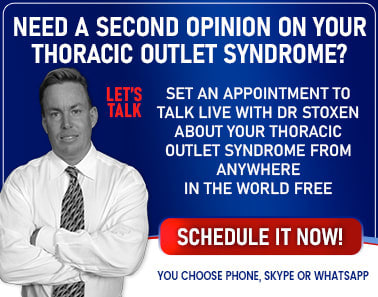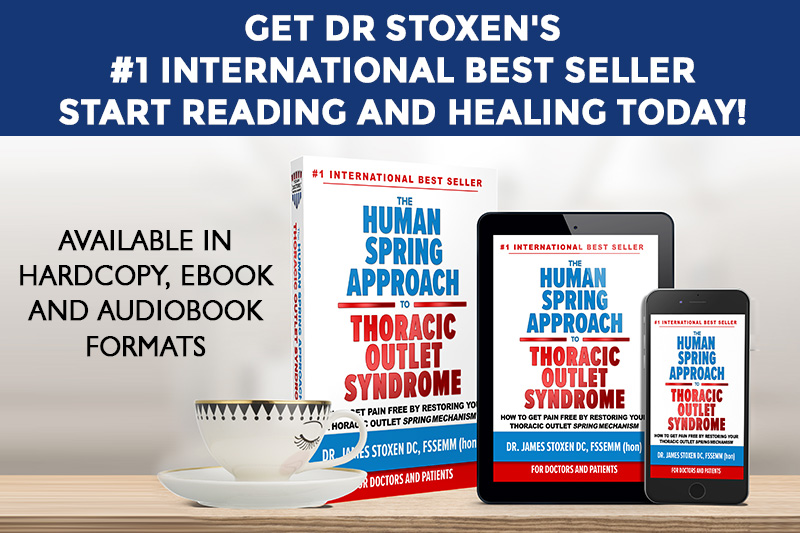THE HUMAN SPRING APPROACH TO
THORACIC OUTLET SYNDROME
by Dr James Stoxen DC., FSSEMM (hon) FWSSEM
GLOSSARY
E
edematous – a condition characterized by an excess of watery fluid collecting in the cavities or tissues of the body.
effort thrombosis – an abnormal condition in which a clot develops within the subclavian or axillary vein following strenuous exercise.
effort thrombosis syndrome – an abnormal condition in which a clot develops within the subclavian or axillary vein following strenuous exercise.
elastic deformation – a temporary deformation of a material’s shape that is self-reversing after removing the force or load.
elastic energy – potential energy that is stored when a body is deformed (as in a coiled spring).
elastic recoil mechanisms – elastic recoil occurs when you convert energy temporarily stored in tendons and fascia into free energy.
elasticity – the ability of an object or material to resume its normal shape after being stretched or compressed; stretchiness.
electrical energy – is energy that is caused by moving electric charges or an electrical impulse.
electrical impulse conduction – overall physiological changes that occur in a neuron due mechanical, chemical or electrical disturbance created by a stimulus. It propagation through axon, synapse and neuromuscular junction is called nerve impulse conduction.
electrical muscle stimulation (EMS, neuromuscular electrical stimulation (NMES), electromyostimulation) – the elicitation of muscle contraction using electric impulses.
electromyogram (EMG) – Electromyography is an electro diagnostic medicine technique for evaluating and recording the electrical activity produced by skeletal muscles.
Electromyography (electromyogram, EMG) – is an electrodiagnostic medicine technique for evaluating and recording the electrical activity produced by skeletal muscles.
electromyostimulation – (neuromuscular electrical stimulation (NMES), electrical muscle stimulation, EMS) – the elicitation of muscle contraction using electric impulses.
elevated arms stress test (EAST, Roos Stress Test) Examines result of loading brachial plexus throughout the thoracic outlet; Stresses arterial, venous, and nervous systems; Patient is seated with arms above 90 degrees of abduction, full external rotation, and elbows flexed to 90 degrees, with head in neutral position.
elevated first rib – when the first rib is pulled or elevated by tension in the scalene muscles.
elevated first rib treatment – treatment for an elevated first rib include the most common one spinal adjustment of the first rib, muscle work to relax the scalene muscles and in rare occasions surgical removal of the first rib.
elevated rib symptoms – symptoms caused by an elevated rib
elongated transverse process – a C7 transverse process that extends beyond a line drawn between the C6 and T1 transverse processes and does not have an articulation or joint with the vertebral body.
embolectomy – the emergency surgical removal of emboli, which are blocking blood circulation. It usually involves removal of thrombi (blood clots), and is then referred to as thrombectomy.
emboli – a blood clot, air bubble, piece of fatty deposit, or other object that has been carried in the bloodstream to lodge in a vessel and cause an embolism.
embolism – obstruction of an artery, typically by a clot of blood or an air bubble.
EMG (needle) – electromyography (EMG) is an electrodiagnostic medicine technique for evaluating and recording the electrical activity produced by skeletal muscles.
emotional stressors – a negative emotional reaction—, which may include fear, anger, anxiety, and suffering.
encroaching – to advance beyond the usual or proper limits.
endovascular intervention – a catheter based intervention to unblock a blood vessel.
engram (negative) – unhealthy brain patterns.
engram (positive) – healthy brain patterns.
engrams – a hypothetical means by which memory traces are stored, a presumed encoding in neural tissue that provides a physical basis for the persistence of memory; a memory trace.
entrapment nerve – a medical condition caused by direct pressure on a nerve
entrapment neuropathy (nerve compression syndrome, compressive neuropathy, peripheral nerve compression) – a medical condition caused by direct pressure on a single nerve.
ephiphany – a moment of sudden or great revelation that usually changes you in some way.
epidural for back pain – epidural steroid injection (ESI) is a minimally invasive procedure for neck, arm, back, and leg pain caused by inflamed spinal joints
equilibrium (dynamic) – dynamic equilibrium the condition of balance between varying, shifting, and opposing forces that is characteristic of living processes.
equilibrium (static) – a particular state of a physical system. qualitatively described by an object at rest and by the sum of all forces, with the sum of all torques acting on that object being equal to zero.
ergonomic – (ergonomics) relating to or designed for efficiency and comfort in the working environment.
ergonomic corrections – corrections designed to reduce stress and eliminate injuries associated with bad posture, the overuse of muscles, and repeated tasks.
ergonomic injuries – ergonomic injuries are those injuries caused by the presence of ergonomic risk factors. It is often a combination of these risk factors that, over time, can lead to pain, injury, and disability. An injury can occur when there is ongoing exposure to ergonomic risk factors.
Etidocaine – (Duranest) – a local anesthetic given by injection during surgical procedures and labor and delivery.
extension springs – provides extended force when the spring is pulled apart from its original length.
external respiratory nerve of Bell (thorasicus longus nerve, long thoracic nerve, posterior thoracic nerve) the nerve that supplies the serratus anterior muscle. This nerve is susceptible to damage during surgery to decompress the thoracic outlet. If it gets cut it may result in winging of the scapula.
external weight – (friction, applied, normal, air resistance and tension forces) doing work upon an object.
extremity adjusting – extremity Adjusting is an adjustment or manipulation used to correct joint fixations anywhere in the body other than the spine.

Meet Dr James Stoxen DC., FSSEMM (hon)
President, Team Doctors® Masters Academy
www.drstoxen.com
Dr Stoxen’s Curriculum Vitae
Stay connected to our thoracic outlet syndrome social media sites
1.1k
Members

READ THESE CHAPTERS OF DR STOXENS BOOK FREE HERE!
ARTICLE CATEGORIES
- Testimonials (13)
- Success Stories (13)
- Failed TOS Surgery (1)
- Thoracic Outlet Syndrome (11)
- Compartment Syndrome – Forearm (5)
- Shoulder Replacement Surgery (1)
- Cervical Discectomy (1)
- Cervical Fusion Surgery (1)
- What is TOS? (3)
- Thoracic Outlet Anatomy (1)
- Thoracic Outlet Engineering (1)
- Causes Of TOS (6)
- The TOS Examination (1)
- Diagnostic Tests for TOS (1)
- What Mimics TOS? (1)
- Paget-Schroetter Syndrome (2)
- TOS Surgery (2)
- Posture Tips (1)
- Self Treatment (1)
- What doesn’t work and why? (1)
- What works and why? (1)
- Stretches for TOS (1)
- Exercises for TOS (1)
- Surgery for TOS (1)
- Case Studies (2)
- Chapter Reviews (10)
- Uncategorized (16)
VIDEO TUTORIALS
Subscribe to our newsletter
Team Doctors® Master’s Academy
Professional Development Courses
Launching January 1, 2022!
Team Doctors® Master’s Academy
Patient Self-Care Workshops
Launching January 1, 2022!


















